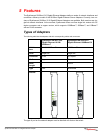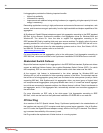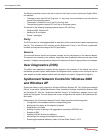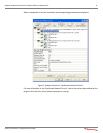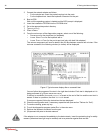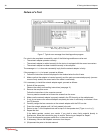
42 5 Features
Virtual LAN (VLAN) support
A Virtual LAN is a group of network devices that belong to the same network segment, regardless of
the physical network structure. A logical network structure based on business requirements is possi-
ble. With virtual networks, physical location no longer specifies the network a user is assigned to:
user clients with similar networking requirements can be united in one network group, or VLAN. This
VLAN can be established to meet a wide variety of organizational or technical needs. All members
of a department can, for example, be gathered into a network group, even if they are distributed over
several buildings. Colleagues working on the same project can be united in a common VLAN, even
if they belong to different departments in different buildings or even different locations. Other net-
work groups can be made invisible to these users. Using Virtual LANs can improve network perfor-
mance, limit broadcast storms, minimize security problems and ease the management task.
By means of frame tagging, SysKonnect SK-98xx V2.0 Gigabit Ethernet Adapters can support up to
64 IP address assignments in a single network connection. Thus, multiple VLANs can be configured
for one port. Stations can be accessed from systems in multiple IP sub nets without traversing rout-
ers. Additionally, multiple application VLANs can be defined to isolate traffic for performance and se-
curity purposes. For this reason, the server can be physically connected to a single switch port but
still belong to several VLANs. The Gigabit Ethernet adapter can receive tagged packets and is able
to tag outgoing packets. The switch the adapter is connected to must support VLAN tagging accord-
ing to IEEE 802.1q.
For several operating systems, SysKonnect offers drivers that support VLAN tagging and thus can
be applied for VLAN servers and terminal units.
For more information on Virtual LANs, refer to the White Paper “Virtual Networks”, which can be
found on the installation CD-ROM under “White Papers” or on our web site under “Technology”.
Also see the corresponding readme files for the respective drivers.
Virtual Cable Tester™ (VCT)
The VCT technology utilizes Time Domain Reflectometry (TDR) technology to remotely diagnose
the quality and characteristics of the attached cables. Using this technology it is possible to detect
and report potential cabling issues such as cable opens, cable shorts or any impedance mismatch-
es in the cable and accurately report - within one meter - the distance to the fault. The VCT technol-
ogy enables the IT manager or the end user to quickly identify the failing mechanism and isolate the
source of the problem.
The VCT feature is only available for SysKonnect SK-9821 V2.0 Gigabit Ethernet 10/100/1000Base-
T Adapters. If the port of a SysKonnect SK-9821 V2.0 Gigabit Ethernet Adapter is selected in the
VCT tab of the SysKonnect Network Control, a table is displayed, which lists the cable pairs, the sta-
tus of the corresponding cable pair, the distance to the fault (length), and the status of the test (see
figure 4). If at the selected adapter a link is up, DSP (Digital Signal Processor) is activated, which
reports the speed of the connection and the length of the cable (only if link is at Gigabit speed). VCT
cannot be started if the link is active.




